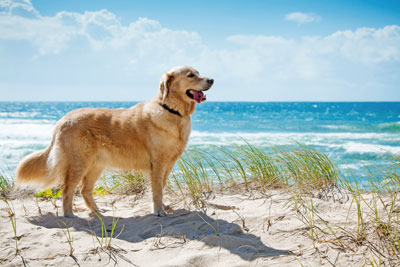Medical Articles
Heatstroke in Pets
Summer is a fun and exciting time of year. During the warm months, pets are less confined to the interior of the house and spend much more time outdoors. Special precautions must be taken to ensure that Rover and Kitty remain healthy and cool during the hot summer days.
Sweating It Out
Sweating is an efficient mechanism for cooling down an overheated body. The human body has millions of sweat glands located in the skin. When the body temperature is elevated, these glands secrete moisture (sweat) on the surface of the skin. Evaporation of this sweat is responsible for cooling down an overheated body.
Dogs and cats, unlike humans, do not cool off by sweating. Instead, they cool themselves by panting. Panting is the process of breathing in through the nose and breathing out through the mouth. As the air passes through the nose and mouth, some evaporation occurs. Panting is not as efficient as sweating, therefore pets have a difficult time coping with the summer heat.

Heatstroke is a serious problem and is a major cause of accidental death in dogs. A pet left in a hot car or an animal that has no shade or water can die from heatstroke in just a short period of time. When you travel with your pet, or if he's left at home, plenty of cool, fresh, drinking water should be available at all times.
Certain animals are particularly sensitive to heatstroke. These include:
- Young, old and overweight animals
- Animals with shortened muzzles (Bulldogs, Pugs, Boxers, Pekinese, Lhasa Apsos, Shih Tzu, Boston Terriers, and Persian cats)
- Animals with heart and / or respiratory problems
- Animals with thick, heavy coats (particularly the northern or cold-breed animals)
Keeping Cool
During the hot summer months, pets should be kept cool. An outdoor doghouse or kennel should be well ventilated and located in the shade. Allowing a dog access to a child's shallow wading pool, filled with an appropriate amount of clean water, is an excellent method for keeping Rover cool during the heat of the day.
Overexertion and intense exercise should be avoided during the middle part of the day. Long walks and heavy exercise should be reserved for the early morning and late afternoon. When taking Rover for a walk, remember that he does not wear shoes. Dogs' paws are sensitive and burn easily on hot blacktop. Blacktop and other hot surfaces should be avoided.
Car Dangers
On warm sunny days, a pet should never be left unattended in an enclosed vehicle. If your pet absolutely must remain in the vehicle, the following precautions are recommended:
- Completely open all windows and vents
- The pet should remain in a well-ventilated cage or kennel
- The vehicle should be parked in a shaded area, out of direct sunlight
- Fresh water should be available
- Return to the vehicle every 10-15 minutes to check up on him (her)
On a warm sunny day, the temperature inside a vehicle can reach 150 degrees within a period of 10-15 minutes. Trapped inside a hot vehicle, a pet can suffer from heatstroke and die very quickly.
If you have concerns about your pet this summer, please call the hospital for information.
[ Search Articles ] [ Article Index ] [ Previous Page ]
